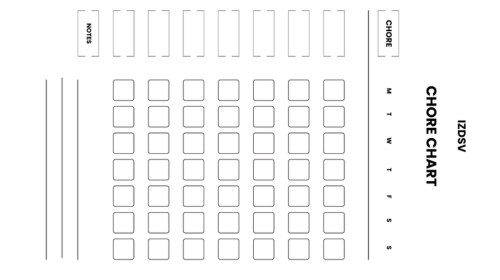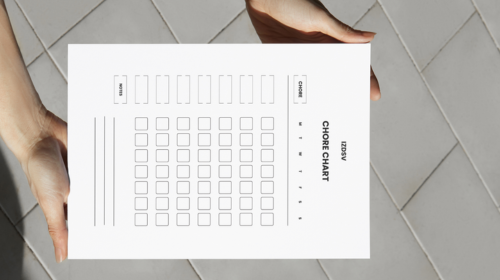Color-Coded Chore Chart for Toddlers: A Simple and Fun Template
Color-Coded Chore Charts
Color-coded chore charts are visual organization tools that assign specific colors to different types of tasks, family members, or completion status. These charts make household responsibilities more engaging and easier to understand, especially for children who respond well to visual cues.
- Visual organization system: Charts use different colors to categorize tasks by type (cleaning, organizing, pet care), difficulty level, or assigned family member
- Age-appropriate tool: Designed to make abstract concepts of responsibility concrete and understandable for young minds
- Customizable format: Can be created as wall charts, magnetic boards, digital apps, or simple paper charts with stickers
- Progress tracking: Colors often indicate completion status (red for not started, yellow for in progress, green for completed)
- Family engagement: Encourages participation from all household members while making chores feel less like work
- Routine builder: Helps establish consistent daily and weekly habits through visual reminders
Benefits of Using a Chore Chart for Kids
Chore charts provide structure and teach valuable life skills while making household tasks feel more like a game than work. They help children develop independence, responsibility, and a sense of contribution to family life.
- Builds responsibility: Children learn to take ownership of tasks and understand their role in maintaining the household
- Develops time management: Kids practice planning and prioritizing tasks within their daily routines
- Increases independence: Reduces the need for constant parental reminders and supervision
- Boosts self-esteem: Completing tasks and seeing visual progress creates feelings of accomplishment and pride
- Teaches life skills: Children learn practical abilities they’ll need as adults, from basic cleaning to organization
- Creates routine: Establishes predictable patterns that help children feel secure and organized
- Reduces family conflict: Clear expectations minimize arguments about who should do what tasks
- Prepares for adulthood: Instills a work ethic and understanding that maintaining a home requires effort from everyone
Why Color Coding Works for Toddlers
Toddlers are naturally drawn to bright colors and visual stimuli, making color-coded systems more engaging than text-based charts. Colors help young children who can’t yet read to understand and remember their responsibilities independently.
- Pre-reading comprehension: Toddlers can understand color associations before they can read words or understand complex instructions
- Visual memory enhancement: Colors create stronger mental connections and make information easier to recall
- Emotional engagement: Bright, cheerful colors make chores feel more fun and less like tedious work
- Simple categorization: Different colors help toddlers sort and organize information in their developing minds
- Immediate recognition: Children can quickly identify their tasks or completion status without needing adult interpretation
- Developmental appropriateness: Matches toddlers’ cognitive abilities and natural learning preferences
- Reduced overwhelm: Colors break down complex information into manageable, digestible pieces
- Increased motivation: Colorful charts are more appealing and encourage participation compared to plain text lists
Designing Your Color-Coded Chore Chart
Creating an effective color-coded chore chart requires thoughtful planning to match your family’s needs and your child’s developmental stage. The design should be simple enough for children to understand independently while comprehensive enough to cover all necessary household tasks.
- Assess family needs: Identify which chores are age-appropriate and necessary for your household’s daily functioning
- Consider child’s abilities: Match chart complexity to your child’s reading level, attention span, and motor skills
- Choose chart format: Decide between wall-mounted boards, magnetic charts, digital apps, or printable templates
- Plan chart size: Ensure the chart is large enough to see clearly, but not so big that it becomes overwhelming
- Select durable materials: Use materials that can withstand daily use, stickers, and potential spills or tears
- Include a reward system: Design space for tracking completed tasks and celebrating achievements
- Make it accessible: Position the chart at the child’s eye level in a high-traffic area like the kitchen or family room
- Plan for updates: Create a system that allows for adding new chores or adjusting difficulty as children grow
Choosing the Right Colors for Different Chores
Color selection should be intuitive and meaningful to help children quickly identify and categorize their responsibilities. Consistent color associations across all family systems reinforces learning and reduces confusion.
- Use intuitive associations: Choose colors that naturally connect to tasks (blue for water-related chores like dishes, green for outdoor tasks)
- Assign difficulty levels: Use light colors for easy tasks, medium tones for moderate difficulty, and darker shades for challenging chores
- Differentiate by room: Assign specific colors to different areas (yellow for kitchen, purple for bedrooms, orange for living areas)
- Consider child preferences: Incorporate your child’s favorite colors to increase engagement and ownership
- Maintain consistency: Use the same color meanings across all charts and family organization systems
- Account for colorblind considerations: Ensure color choices work for family members with color vision differences
- Limit color palette: Stick to 4-6 main colors to avoid confusion and maintain visual clarity
- Create completion indicators: Use one consistent color (like gold or silver) to mark finished tasks across all categories
Creating a Simple Chore Template
A well-designed template provides structure while remaining flexible enough to adapt as your family’s needs change. The template should balance comprehensive task tracking with simplicity that encourages daily use.
- Design clear headers: Include sections for the child’s name, week dates, and any special instructions or goals
- Create task columns: List chores vertically with horizontal rows for each day of the week
- Add completion boxes: Include spaces for stickers, checkmarks, or color-coding to mark finished tasks
- Include reward tracking: Design a section for tracking points, stars, or progress toward larger rewards
- Make it printable: Ensure the template prints clearly on standard paper and fits common frame sizes
- Add visual elements: Include simple graphics, borders, or decorative elements that appeal to children
- Plan for flexibility: Create blank rows for adding new chores or seasonal tasks
- Include instructions: Add a small legend explaining the color system and how to use the chart effectively
Printable and Magnetic Options
Printable and magnetic chore charts offer different advantages depending on your family’s lifestyle and preferences. Printable options provide cost-effective customization and can be easily replaced or updated, while magnetic charts offer durability and reusability for families who prefer long-term solutions.
- Cost comparison: Printable charts require only paper and ink costs, while magnetic options involve a higher upfront investment but a longer lifespan
- Customization level: Printable charts allow complete personalization of design, colors, and layout for each child’s needs
- Durability factors: Magnetic charts withstand daily wear and tear better, while printable versions may need frequent replacement
- Storage convenience: Printable charts can be easily stored digitally and reprinted as needed without taking up physical space
- Portability options: Printable charts work well for travel or temporary living situations, magnetic charts better suit permanent home setups
- Environmental considerations: Magnetic charts reduce paper waste over time, while printable options allow recycling when outdated
- Setup requirements: Printable charts need printer access and possibly laminating materials, magnetic charts require a metal surface or magnetic board
- Child interaction: Both options support sticker systems and visual tracking, but magnetic pieces may be more engaging for hands-on learners
How to Create a Free Printable Chore Chart
Creating your own printable chore chart allows complete customization while keeping costs minimal and ensuring the chart perfectly fits your family’s needs. Free online tools and basic computer programs provide everything necessary to design professional-looking charts at home.
- Use free design software: Canva, Google Docs, or Microsoft Word templates provide user-friendly chart creation tools
- Download free templates: Websites like Pinterest, Teachers Pay Teachers free section, or parenting blogs offer ready-made designs
- Choose appropriate dimensions: Design for standard 8.5×11 inch paper or larger poster sizes, depending on your display needs
- Select printer-friendly colors: Use colors that print clearly on home printers and won’t drain ink cartridges quickly
- Include interactive elements: Add checkbox squares, star outlines, or sticker placement areas for child engagement
- Create multiple versions: Design weekly, monthly, and seasonal variations to maintain interest and accommodate changing routines
- Add laminating consideration: Design with laminating in mind if you plan to use dry-erase markers for reusability
- Test print quality: Print a sample copy to ensure colors, text size, and layout work well before finalizing the design
Using a Magnetic Dry Erase Chart for Flexibility
Magnetic dry-erase charts provide the ultimate flexibility for families with changing schedules or children who benefit from tactile interaction with their chore systems. These charts adapt easily to new routines without requiring a complete redesign or reprinting.
- Invest in quality materials: Choose magnetic boards with smooth writing surfaces and strong magnets that won’t slide or fall
- Use color-coded magnetic pieces: Assign different colored magnets to family members, chore categories, or completion status
- Create moveable task cards: Write chores on magnetic strips that can be repositioned as schedules or abilities change
- Establish clear systems: Develop consistent rules for moving magnets or erasing marks to avoid confusion
- Plan for multiple users: Ensure the chart is large enough for all family members to use simultaneously without crowding
- Stock appropriate markers: Keep a variety of dry erase marker colors specifically designated for chart use
- Maintain the surface: Clean the board regularly to prevent ghosting and ensure markers erase completely
- Design backup systems: Keep extra magnetic pieces and markers available for replacements when pieces get lost or damaged
Implementing the Chore Chart in Your Family Routine
Successfully integrating a chore chart into family life requires strategic planning and consistent execution to make it feel natural rather than burdensome. The key is starting gradually and building momentum through positive experiences that reinforce the value of the system for everyone involved.
- Start with a simple introduction: Begin with just 2-3 basic chores to avoid overwhelming children and allow them to experience success
- Establish clear expectations: Hold a family meeting to explain how the chart works, what each color means, and what happens when tasks are completed
- Create consistent timing: Designate specific times of day for chart check-ins, such as after breakfast and before dinner
- Link to existing routines: Attach chore chart activities to already established habits like getting dressed or eating meals
- Model enthusiasm: Show genuine excitement about the chart system to encourage children’s positive attitudes toward participation
- Plan for resistance: Expect initial pushback and have strategies ready for gentle encouragement without turning chores into battles
- Involve the whole family: Ensure all family members participate in some capacity to demonstrate that household maintenance is everyone’s responsibility
- Allow adjustment period: Give the system 2-3 weeks to become habit before making major changes or declaring it unsuccessful
Incorporating the Chore Chart into Morning Routines
Morning routines provide an ideal foundation for chore chart success because children are typically most cooperative and energetic at the start of the day. Building chores into the morning schedule helps ensure tasks get completed before afternoon fatigue or after-school activities interfere.
- Wake-up preparation: Include a chart review as part of getting out of bed, so children know their daily expectations immediately
- Breakfast connection: Make chart checking part of the breakfast routine, reviewing tasks while eating or immediately afterward
- Before school completion: Schedule quick morning chores like making beds or feeding pets before leaving for school
- Visual placement strategy: Position the chart where children naturally look during morning preparations, such as near the bathroom mirror or kitchen table
- Time management teaching: Help children estimate how long tasks take so they can plan their morning schedule effectively
- Celebration moments: Build in a brief acknowledgment or praise when morning chores are completed successfully
- Backup planning: Have alternative arrangements for rushed mornings or unexpected schedule changes
- Weekend modifications: Adjust morning expectations for weekends when schedules are more flexible and additional tasks can be included
Encouraging Kids to Use the Chart Regularly
Consistent chart usage requires making the system rewarding and engaging rather than feeling like additional work or pressure. Children respond best when they feel ownership over the process and see clear benefits from their participation.
- Celebrate small wins: Acknowledge every completed task enthusiastically, especially during the first few weeks of implementation
- Create meaningful rewards: Connect chart completion to privileges or activities children genuinely value, not just material prizes
- Allow chart personalization: Let children add decorative elements, choose sticker types, or suggest modifications to increase their investment
- Make it social: Encourage siblings to cheer each other on and celebrate family achievements together
- Address forgetfulness kindly: Use gentle reminders rather than criticism when children forget to use the chart
- Vary the routine: Occasionally change reward systems, add bonus challenges, or introduce seasonal themes to maintain interest
- Connect to independence: Help children understand how completing chores builds their capability and trustworthiness for greater freedoms
- Track long-term progress: Keep records of improvement over time and share these successes with children to build confidence and motivation
Tips for Success with Your Family Chore Chart
Long-term chore chart success depends on maintaining realistic expectations while staying flexible enough to adapt as your family grows and changes. The most effective approach balances structure with understanding that some days will be better than others, and that’s perfectly normal.
- Start small and build gradually: Begin with 1-2 simple tasks per child and add complexity only after consistent success with basics
- Maintain consistency yourself: Parents must model reliability by checking charts regularly and following through on promised rewards
- Accept imperfection gracefully: Expect missed days, forgotten tasks, and occasional resistance without abandoning the entire system
- Adjust age-appropriately: Modify expectations as children develop new skills and lose interest in systems that feel too childish
- Create family ownership: Make the chart a family project where everyone contributes ideas and feels invested in its success
- Plan for busy periods: Have simplified versions ready for stressful weeks, holidays, or times when routines are disrupted
- Stay positive and focused: Emphasize what children accomplish rather than dwelling on incomplete tasks or missed opportunities
- Review and revise regularly: Schedule monthly family meetings to discuss what’s working well and what needs adjustment
Setting Realistic Expectations for Toddlers
Toddlers have unique developmental needs that require specially adapted expectations and approaches to make chore charts successful rather than frustrating. Understanding their natural limitations and capabilities helps create positive experiences that build confidence and cooperation.
- Focus on effort over perfection: Praise attempts and improvement rather than expecting adult-level completion of tasks
- Keep tasks very simple: Choose activities like putting toys in bins, carrying lightweight items, or wiping surfaces rather than complex multi-step chores
- Limit daily expectations: Start with just one task per day to avoid overwhelming developing attention spans and executive function skills
- Build on natural interests: Incorporate activities toddlers already enjoy, like sorting objects by color or helping with cooking preparation
- Allow extra time: Toddler pace is naturally slower, so build in sufficient time for task completion without rushing
- Provide hands-on guidance: Work alongside toddlers initially, gradually reducing assistance as they master each skill
- Use immediate rewards: Toddlers need quick acknowledgment rather than delayed gratification systems that work for older children
- Expect developmental fluctuations: Some days will be better than others based on mood, energy levels, and natural toddler unpredictability
Celebrating Achievements and Progress
Meaningful celebration of chore chart success builds intrinsic motivation and helps children develop positive associations with responsibility and contribution. The key is making recognition feel genuine and proportionate to the effort invested.
- Acknowledge daily efforts: Provide immediate verbal praise or high-fives when children complete tasks without being reminded
- Create milestone celebrations: Plan special activities or privileges when children reach weekly or monthly completion goals
- Display progress visually: Use star charts, sticker collections, or photo documentation to help children see their growth over time
- Share successes with others: Tell grandparents, teachers, or family friends about children’s helpfulness to boost pride and confidence
- Connect achievements to benefits: Help children understand how their contributions make family life easier and more enjoyable for everyone
- Vary celebration types: Rotate between extra privileges, special outings, favorite meals, or small surprises to maintain excitement
- Include peer recognition: Encourage siblings to acknowledge each other’s efforts and celebrate family teamwork achievements
- Document the journey: Take photos of children using their charts or completing tasks to create positive memories of their growing responsibility
Color-coded chore charts represent a powerful tool for building family harmony while teaching essential life skills that will serve children throughout their development. The visual nature of these systems makes household responsibilities accessible and engaging for young minds who are just beginning to understand their role in family life.
- Long-term skill development: Children who use chore charts develop time management, responsibility, and a work ethic that benefits them academically and socially
- Family relationship strengthening: Shared household responsibilities create opportunities for teamwork, communication, and mutual appreciation among family members
- Independence building foundation: Early exposure to structured responsibility helps children develop confidence in their abilities to contribute meaningfully
- Adaptability across ages: Color-coded systems can evolve with children from simple toddler tasks to complex teenage responsibilities
- Stress reduction for parents: Clear expectations and visual tracking systems reduce the need for constant reminders and negotiations
- Character development support: Regular completion of household tasks builds integrity, persistence, and understanding of commitment
- Preparation for adult life: Children who grow up with chore charts transition more easily to managing their own homes and responsibilities
- Positive family culture creation: Establishing that everyone contributes to household maintenance builds a cooperative rather than entitled family atmosphere
Using a Color-Coded Chore Chart for Toddlers
Implementing a color-coded chore chart system with toddlers requires patience, creativity, and realistic expectations, but the investment pays dividends in child development and family dynamics. The key to success lies in remembering that the goal is building positive associations with responsibility rather than achieving perfect task completion.
- Embrace the learning process: Toddlers will need significant time and support to master even simple tasks, and that’s exactly as it should be
- Focus on character over chores: The real value lies in teaching helpfulness, cooperation, and pride in contribution rather than pristine task execution
- Celebrate small victories: Every attempt, every improvement, and every willing participation deserves recognition and encouragement
- Maintain flexibility: Successful systems adapt to changing family needs, developmental stages, and seasonal life variations
- Remember developmental appropriateness: What works for a 2-year-old will need modification for a 4-year-old, and that evolution is natural and healthy
- Build positive memories: The experience of using chore charts should create fond memories of family cooperation rather than stress or conflict
- Trust the process: Consistency over time produces remarkable results, even when daily progress feels minimal or inconsistent
- Invest in relationship: The time spent implementing and maintaining chore charts strengthens parent-child bonds through shared accomplishment and mutual respect




